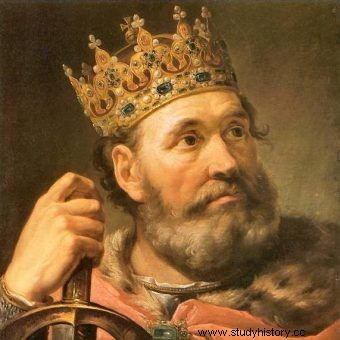
Bolesław the Brave according to Marcello Bacciarelli.
Bolesław I the Brave (the first king of Poland)
The ruler of the Piast dynasty, the first king of Poland. Son of Mieszko I and Dobrawa. One of the most warlike monarchs in the history of the country and the founder of a vast superpower based on plunder and conquest. He had many years of conflicts with the majority of his neighbors:with Germany for the borderlands of Milsko and Lusatia, with the Czechs for power over their country and for Moravia, and with the Ruthenians - for placing on the Kiev throne, if not himself, then at least his son-in-law. He also engaged in conflicts with Prussia and Hungary, which were poorly confirmed in sources.
He began to reign in 992, but initially, under his father's decisions, he probably ruled only one of the country's districts. It was only three years later that he chased his stepmother Oda and three brothers away, and gathered all power in his hands. Soon, the Bishop of Prague, Wojciech, who was in Rome during the bloody events, also came here. It was intended to carry out a missionary action among the Gentiles. Working together with the Polish prince, he decided to go to Prussia, which was adjacent to the Piast state.
In 997, under the escort of Bolesław's warriors, Wojciech reached Gdańsk, and from there, without armed protection, to the country of Prussia, where on April 23 he was martyred. The Polish ruler, Bolesław the Brave, according to some messages, bought the martyr's body worth its weight in gold and deposited it in Gniezno, which gave rise to the cult of this saint. The quick canonization of St. Wojciech allowed for efforts to create a church metropolis in Poland. Already in 999, the Holy See consented to the establishment of the Archbishopric of Saint Adalbert. This decision was confirmed at the ceremonial congress of Gniezno in March 1000, where Emperor Otto III came on a pilgrimage to the tomb of the new saint. The state of Bolesław received an independent church organization (metropolis), the capital of which was Gniezno, and the brother of St. Wojciech - Radzim-Gaudenty. Additionally, bishoprics were created in Kraków, Wrocław and Kołobrzeg. Bishop Unger, who was independent of the metropolitan of Gniezno for life, resided in Poznań. After his death, the Poznań diocese was to be subordinated to Gniezno.
Emperor Otto III, during the Gniezno Congress, decorated Bolesław's head with his imperial diadem. In the Polish chronicling tradition, this event - wrongly - was perpetuated as a royal coronation. In fact, at best, a coronation was announced in Gniezno, which at that time did not take place due to the sudden death of Emperor Otto III.
Bolesław the Brave had significant military successes in the clash with better-armed and more numerous German troops. He used deceptions and led to the deliberate exhaustion of enemy forces, while avoiding clashes in the open field. In 1015, he triumphed in an important clash on the land of Dziadoszan. The defense of Niemcza, which was successfully carried out by his forces in 1017, also went down in history. As the only ruler in Polish history, Bolesław conquered significant German lands. The final peace was concluded in Budziszyn in 1018. Under it, Bolesław kept Milsko and Łużyce. Probably during the bloody struggle with Henryk, Western Pomerania broke away from the Piast state and the bishopric in Kołobrzeg that had been established there collapsed. He also settled in Prague for a short time and sat on the throne there as Bolesław IV. After the Kiev expedition, which brought considerable loot and regained the Czerwieński Grody, lost at the end of Mieszko's reign.
In 1013 he arranged the wedding of his son, Mieszko Lambert, with the imperial niece Rycheza. In turn, in 1018, he won a spectacular victory in the Battle of the Bug, then entered Kiev and drove the local prince, Jarosław the Wise. For many years his wife Emnilda played an important role at his side.
The reign of Brave turned out to be crucial for the consolidation of Christianity in the country. The ruler skillfully used the death of the missionary Wojciech and created his image as a declared promoter of the word of God. During his time, the construction of a number of monumental stone palaces and churches began. There are many indications that the ruler deliberately created a legend according to which it was he, not his father, who introduced a new faith in Poland. Some historians believe that at the end of his life, Bolesław began to dream not only about the royal ordination, but also about building a new Slavic "empire". He was crowned a few weeks before his death, on April 18, 1025. The death of the Polish king took place on June 17, 1025.
Not only Polish chroniclers wrote about his achievements, but also Bishop Merseburg Thietmar, who worked in copper. For Gallus Anonymus, he was Bolesław the "Great". Meanwhile, the German historian compared him to Satan himself. The first Polish king, Bolesław, received the nickname "Chrobry" only several hundred years after his death.
